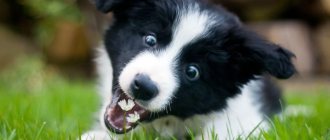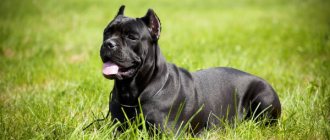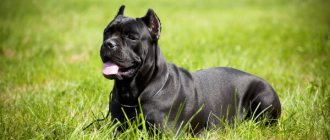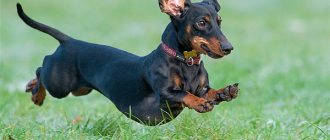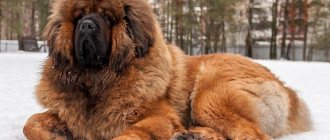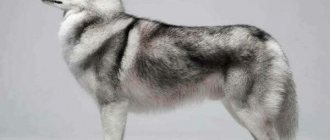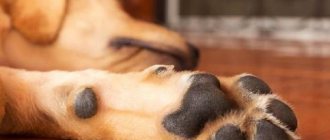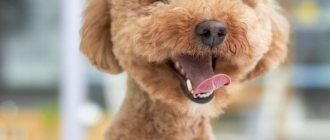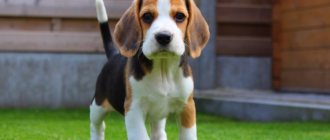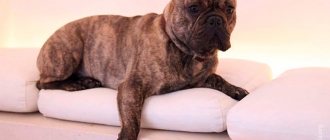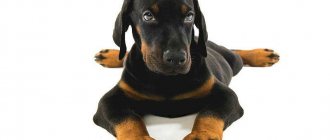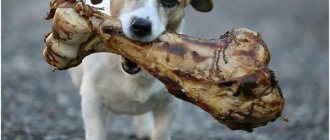The Akita Inu breed appeared in 1600 in the Japanese province of Akita, from where the dogs got their name. They were intended to protect royalty. They were also used for hunting large animals, such as bears.
In the 20th century, representatives of this breed came to America. Akita Inu became popular after the story, and later the film adaptation, Hachiko. Then the breed became famous throughout the world.
Many families wanted Akita Inu as their pet. They can be described as loving, reserved, loyal and fearless.
Breed card
- Famous breed names: Akita Ken, Japanese Akita, Akita, Akita Matagi
- FCI breed number: 255
- Description of the standard on the FCI website: link
- Height at the withers: males - up to 67 cm, females - up to 61 cm
- Weight of an adult dog: for males - up to 65 kg, for females - up to 45 kg
- Color options: white, brindle, red-fawn, sesame
- Lifespan: up to 12 years
- Cost of a puppy: about 50,000 rubles
- Size: 4 out of 5
- Learning ability: 3 out of 5
- Attitude towards children: 3 out of 5
- Shedding intensity: 5 out of 5
- Protective and guard qualities: 5 out of 5
Training at 3 months. Socialization
Three months is an important stage in introducing an Akita Inu puppy to the outside world. Your first walks should be short and not too tiring for the puppy. You should start with 15 minutes, gradually increasing the walking time to 1 hour.
Correct formation of the nervous system
At this age, the puppy’s nervous system is forming.
. It has been proven that raising puppies in isolation during this important period contributed to the development of pronounced cowardice in them later. It is necessary to show the puppy as much as possible: noisy streets, large crowds of people, etc. Everything that he will have to face in later life.
Characteristic
Akita Inu is a companion dog of a discreet nature, in the FCI classification it belongs to Spitz and related primitive breeds. There are no performance tests for dogs.
Breed standard FCI No. 255
Akita Inu is a balanced dog, quite large and noble in appearance. He behaves with restraint and obedience, without aggression.
Head size in proportion to the dog's body. The frontal part is wide, without folds. There is a pronounced groove on the Akita's forehead, and a stop line is also noticeable. The muzzle is of moderate length - the base is wide, slightly tapering towards the black lobe. Partial depigmentation of the lobe is acceptable for light-colored dogs. The teeth are moderate, even, covered with dense lips - a scissor bite.
At the level of the stop, the eyes are almost triangular in shape. The outer corners are raised relative to the inner ones. Eye color is dark brown. The erect ears are set moderately wide at the top of the skull and covered with a layer of dense, soft hair. Slightly inclined towards the muzzle.
The neck is thick, without dewlap, covered with a voluminous collar, flowing into the line of a strong back. The chest is deep, the ribs are slightly curved, the belly line rises up from the chest to the groin area. The croup is completed by a thick tail set high. It is twisted into a ring and thrown as far as possible onto the back.
The paws are thick and strong, the toes are arched, gathered into a dense ball. The elbows of the forelimbs are tightly pressed to the body, the hock joints of the hind limbs are developed, due to which the dog moves elastically and quickly.
Akitas have pronounced gender differences, and any physiological deviation based on gender is considered a defect, when females are similar in appearance to males and vice versa.
Other deviations leading to disqualification:
- snack, undershot;
- incomplete dental formula;
- short tail;
- aggressiveness, timidity;
- blue or black spots on the tongue;
- excessively long hair;
- drooping ears;
- black mask on the face;
- spots with white color.
Dimensions, weight and height of the breed
The permissible weight for Akitas is not specified in the standard - breed experts focus on the proportionality of the animals. The height for males should be up to 67 cm, for females - up to 61 cm, while the body proportions are as follows - the height is 10/11 of the length of the body.
Breeders note that the weight of males reaches 59-65 kg, females - 32-45 kg.
Possible colors
The Akita Inu has a straight coat - the guard hair is coarse, and the undercoat is soft and downy. The length of the coat is medium, slightly higher on the tail, withers and rump area.
Types of colors allowed for Akita Inu:
- white;
- brindle;
- red-fawn;
- sesame is an analogue of red-fawn, with dark ends of hair.
With all types of color, representatives of the breed have whitish hairs on the face - in the area of the cheekbones, lips and lower jaw. There are also such hairs on the body - they are called “urajiro”.
Puppy weight by month
Weight differences between Akita Inu females and males appear from childhood. The owner must monitor the development of the puppy and, if necessary, adjust the diet.
Weight-to-height ratio for Akita females:
- 1 month – 2.7 kg;
- 2 months – 5 kg;
- 3 months – 9.5 kg;
- 4 months – 12.5 kg;
- 5 months – 15.5 kg;
- 6 months – 17.5 kg;
- 7 months – 19 kg;
- 8 months – 20 kg;
- 9 months – 21.5 kg;
- 10 months – 21.5 kg;
- 11 months – 22 kg;
- 12 months – 25 kg.
Weight-height ratio for male Akita Inu:
- 1 month – 2.7 kg;
- 2 months – 7.5 kg;
- 3 months – 15 kg;
- 4 months – 20 kg;
- 5 months – 25 kg;
- 6 months – 30 kg;
- 7 months – 32.5 kg;
- 8 months – 35 kg;
- 9 months – 36 kg;
- 10 months – 37 kg;
- 11 months – 37.5 kg;
- 12 months – 38 kg.
Indicators are approximate and vary depending on the physical parameters of the puppy’s parents.
Lifespan
Akita Inus live 10-12 years, which is slightly less than the average for large breeds. Experts say that the war contributed to the reduction in life expectancy - before it, Akitas lived 14-15 years. Today, females live longer than males by 2-6 months.
Allergenicity
Akita Inu has a pronounced seasonal shedding, and the undercoat collects dust. It is believed that the dog is not suitable for allergy sufferers - there are known cases when representatives of the breed caused allergies. To make sure there is no negative immune reaction to the undercoat or guard hair, it is recommended to take allergy tests.
Price of a small dog
You need to purchase a puppy of this noble Japanese breed from experienced, trusted breeders. Who will sell a healthy dog and help, if necessary, with advice.
The price of Akita Inu puppies depends on several factors:
- Exterior.
- The origin of the puppies and their pedigree.
- Compliance with the standard.
- The level of the nursery and its remoteness. For example, buying a dog of the same level in the region is cheaper than in Moscow.
Japanese breed puppies can be purchased for 2500-7000 rubles . With veterinary passport and puppy card for 4000-9000 rubles.
But in elite nurseries or clubs, pet-class puppies will already cost from 30,000 rubles.
Puppies for exhibitions or breeding are 3 times more expensive. In the regions, prices for Akita dogs will be 20% lower.
How to choose the right pet?
Now in Russia the Akita Inu breed is very popular. Therefore, purchasing a pet will not be difficult . To do this, you must first decide for what purpose you need the dog and choose a good breeder.
In order to choose a puppy, you need to consider several factors:
- study the pedigree of the parents;
- ask the breeder whether the animals have undergone the necessary health tests;
- carefully familiarize yourself with the advantages and disadvantages of puppies.
Cost in Russia
The price of a puppy depends on the purpose for which it is purchased . There are three varieties:
- Show class - strong dogs with a healthy psyche and excellent temperament. Excellent for exhibitions, but not always for breeding. Price in Russia – from 80,000 rubles.
- Breed class – intended for breeding. But they too are exhibited and receive champion titles. Price in Russia – from 40,000 to 80,000 rubles.
- Pet class – puppies that were born in a planned litter and have some disadvantages for show:
- absence of one or two testes;
dental defect;
- The color does not match the standard.
Such dogs are not allowed for exhibitions or breeding, but this does not prevent them from becoming a wonderful pet. Cost – 15,000 – 30,000 rubles.
History of the breed
Japanese Akitas, bred in the district of the same name, were initially medium in size - there were no large representatives of the breed. Dogs have been used since 1603 for bear hunting and fighting. The fighting animals were called Akita-Matagi - they were crossed with mastiffs and Tosa Inu to obtain the desired character traits, while the external resemblance to the Spitz was lost. 200 years later, when fighting was officially banned, they did not stop breeding Japanese dogs - selection was directed towards enlarging the breed.
During World War II, Akitas and others were raised for their pelts, which were used to make warm fur clothing. The exception was service shepherd dogs, mainly German. Japanese Akitas were crossed with “Germans” to prevent them from being killed and to hide their origin. After the war, three breed types of dogs emerged:
- fighting Akita;
- Akita-Matagi;
- Akita Shepherd.
The situation with the purity of the breed was unclear. The breeders identified one male named Kongo-go, the most typical in appearance, and made every effort to restore the line. Matings were carried out with Matagi-Akita - as a result, a population of dogs was obtained that were stable in characteristics and brought “pure” offspring.
Factors influencing growth
At each stage of Akita development there are important factors that determine it. During the period of “childhood” (1-6 months), the puppy quickly gains weight, its skeleton grows at the highest speed. At this stage, the first thing you need to take care of is the quality of the dog’s nutrition and the proper frequency of meals. But overfeeding an Akita is harmful - it will not speed up development, but will provoke the development of obesity. In addition to food, due attention is paid to other factors:
- Conditions for keeping the dog.
- Active life, physical exercise.
- Taking into account the genetic characteristics of an individual animal.
At the “adolescent” stage of development, active growth slows down. The animal begins to “grow” in width. The chest is enlarged and the muscle frame is strengthened. Akita Inu also actively wastes energy - high-calorie food must replenish it in a timely manner.
At the third stage of development (1-3 years), the animal continues to build muscle mass. Growth and weight gain are completed - it is necessary to monitor the volume of portions and reduce the frequency of feedings.
In order for the Akita Inu to develop harmoniously and grow up as a healthy and strong dog, you should pay attention to the advice of experts:
- To prevent the stress of separation from its mother from affecting the development of the puppy, he is prescribed a special diet: calcined cottage cheese, egg yolk, whey, and a multivitamin complex.
- The dog's food should not be fatty.
- The Akita Inu diet changes according to the seasons: in winter - more meat, in summer - more vegetables and dairy products.
- If a puppy, with proper nutrition and maintenance, lags behind its brothers and sisters in development, the first thing to suspect is a helminthic infestation.
- The second common cause of delayed development is a lack of vital vitamins and minerals. Only a qualified veterinarian can prescribe the necessary supplements for your baby.
- It is worth considering that Akitas by nature develop slowly - over the course of 3 years.
Character
Akita Inu are calm and sociable dogs of a reserved nature. They are not inclined to show aggression and bark loudly. They are clean and do not smell like “dog,” which is why their owners compare them to cats.
Akitas are independent, independent and have a strong hunting instinct. They are possessive, so they can be jealous of other animals and require early socialization.
For a dog, the Japanese Akita is unusually cunning - it does not act at the level of reflexes, like others, but remembers and generalizes situations and actions that are beneficial to itself. The dog sees when the owner is happy, and with pleasure repeats the actions that delight him. Having done something wrong, she prudently uses her abilities to evoke pleasant emotions in her owner and avoid punishment.
Akitas are different in character, despite the common breed characteristics. Among them there are lazy phlegmatic people, excitable choleric people, stable sanguine people and even cowardly melancholic people. Negative temperaments are formed through improper breeding, when undesirable qualities are accidentally or intentionally maintained.
Raising puppies
Despite its cute, plush appearance, the Akita Inu is a temperamental dog . You need to start raising your pet from an early age, otherwise the animal will later become uncontrollable.
A devoted pet that sincerely loves its owner remains a proud representative of the Japanese breed. He will never agree to submission. Therefore, to build a good relationship with an Akita, you need to treat him as an equal.
From the first months of life, the animal must understand how to treat its members and how to treat guests. By nature, the Akita Inu remains a predator and is ready to show its fighting traits at any moment.
In order for a dog to best accept a family, it must constantly communicate with members of the household, especially with children. In an atmosphere of love, the Akita Inu will quickly get used to its new home , fall in love with its surroundings and become an excellent protector.
Learning ability
Akita Inu easily adapt to living conditions and are trainable. Rumors about their stubbornness and destructive behavior appear more likely due to incorrect actions of trainers, reinforcing undesirable behavior during classes.
Akita Inu training rules:
- Form desirable behavior from the moment the puppy arrives in the house. Observe discipline strictly - persistently and patiently explain to the puppy exactly what actions are unpleasant to you.
- Prevent dominance on the part of the dog. Akita gets excited in an unusual situation, demanding the owner's attention, and in moments of boredom, it barks and whines. This behavior should be stopped by providing the dog with sufficient exercise and requiring commands to be followed. If security qualities are undesirable, stop their manifestation.
- Conduct training consistently, bringing each command to automaticity and only then introducing a new one.
- Be tougher than a dog. Having driven her out of bed once, patiently repeat the procedure every time the Akita jumps onto the bed. If you expose him to unwanted behavior once, the dog will feel like a leader and will manipulate the owner.
- Understand the dog’s way of thinking and demand only doable things from it.
- Reinforce positive actions with a treat or game - always!
- Take breaks if the dog is tired. But do not confuse fatigue and the desire to cheat.
- The strength of punishment should be chosen in accordance with the offense. Hitting the dog is prohibited!
You need to react the same way to the same actions. If today you were happy when a dog jumped into your arms, and tomorrow you forbade it and cursed, it ceases to understand what is true.
Akita Inu and baiting
It is better to start training an Akita Inu from the age of one and a half years. It is important that the dog already clearly follows basic commands.
Baiting is organized at special hunting bases, where animals are kept on a leash. The dog must find prey by scent trail. Only after this is he brought to the game, encouraging excitement and aggression.
It is better not to carry out such an operation for a novice hunter. It is advisable to trust an experienced dog handler who specializes specifically in Akita Inu.
Content
Akita Inu is not suitable for apartment living, although some breeders claim that this is possible with sufficient stress. In the house, the dog is taught that the owner’s things are inviolable, and he can take any “animal” belongings.
Need for physical activity
It is better to walk Akita Inu in public places on a leash - it is prone to aggression towards other dogs. At the same time, two hours of active walks a day are required. If there is a place in your city where you can normally walk with your pet without fear of loss or unexpected aggression, the dog will take root in the apartment.
Excessive stress is unacceptable for a dog.
Why you should train your Akita to walk on a leash:
- correct excessive tension on the leash with sharp and short jerks, repeating “don’t pull” or “quiet”;
- step over a trailing leash tangled between the paws;
- bypass obstacles - pillars or trees, on command.
Appearance care
The Japanese Akita's coat sheds seasonally and requires grooming once a week. It is also important to trim your dog's nails and wash him occasionally.
To care for an Akita Inu, you will need the following tools:
- slicker;
- furminator;
- zoo shampoo;
- large claw clipper;
- Toothbrush;
- massage brush.
A puppy's teeth change at 4 months and require cleaning every two to three days. The plaque is removed with a brush with a special paste. Once a week, the dog is given chewing bones and cartilage to clean its teeth. The eyes are wiped with a cotton pad moistened with water or lotion, such as “Diamond Eyes”. Ear wax is removed 3-4 times a month with a piece of cotton wool wrapped in a bandage. Excessively long claws are carefully trimmed using a nail clipper.
Nutrition
When feeding Akita Inu, you can use a mixed type of food, adding dry food to natural food. But it is easier to use ready-made food of a balanced composition. Akitas are picky eaters, so choosing food can be difficult. In some cases, dogs refuse to eat due to allergies. When changing food or type of food, it is important to monitor the condition of the dog’s skin, coat, and digestion. The number of feedings determines the age of the dog - two-month-old puppies are fed 5 times, four-month-old puppies - 3 times, adults - 2 times a day.
Diet for babies
For the full development of puppies of this breed, a proper diet . Which will include meat, fish and dairy products.
Since the breed originally lived on the island, the predisposition to feeding on seafood is inherent at the genetic level. But at first, when such products are introduced, the puppy may refuse them. There is no point in insisting. The best solution would be to try again after some time. In about 7 days.
You can even add seaweed to your daily meals, for example in tablet form. This will give the body the required amount of iodine.
The Akita Inu's diet must certainly consist of:
- Fermented milk products: kefir, yogurt, cottage cheese, yogurt.
- Unsalted cheeses.
- Boiled eggs, but no more than 2 per week.
- Raw meat: rabbit, horse meat, lamb. If the animal is not allergic, you can include beef, veal, and poultry.
Before feeding your dog raw meat, it must first be kept in the freezer. This will destroy all parasites that are usually killed by heat treatment.
Bones must be carefully removed, especially when it comes to feeding a puppy. But, since fish bones are a source of calcium, the carcass itself along with them can be ground in a blender or meat grinder. The amount of fish served should be double the portion of meat.
Typical diseases of this breed
There are no diseases specific to the Japanese Akita. She is susceptible to typical diseases that most dogs suffer as they age.
List of possible diseases:
- infections (plague, leptospirosis, hepatitis, parvovirus);
- gastrointestinal diseases (diarrhea, helminths, constipation, poisoning);
- skin problems (allergies, scabies);
- eversion of the eyelid;
- umbilical hernia;
- joint dislocations;
- ear diseases;
- cataract and glaucoma.
To what age do they grow?
- Dogs grow slowly, reaching their final development by three years. At first, puppies actively gain weight.
- Up to six months they are very large, not much like adult animals.
- Six months of age brings changes in the appearance of the puppy. The dog becomes more fit, breed characteristics are more clearly visible.
- At one year of age, bitches begin to go into heat, but for an Akita this is not a sign of “adulthood.”
- From one to two years the animal grows very slowly, but changes in appearance continue. The shape of the head changes noticeably.
- At two years of age, growth stops, but physical development continues.
Buying a puppy
You need to choose a puppy exclusively from a nursery.
It is worth carefully examining the dog.
Characteristics of a purebred Akita:
- the ears are thick, proportional to the muzzle;
- the eyelids are thick, the eyes are dark brown;
- dense bones;
- limbs are harmonious;
- lively and adequate character;
- tendency to gregarious behavior.
Be sure to ask the breeder for kennel documents, a puppy card and a veterinary passport with stamps on the vaccinations given.
How to care
Care is directly related to age characteristics; it is necessary to take into account the standards of education and nutrition. Its unpretentiousness and thick coat make it possible to keep animals in enclosures or ordinary apartments.
The coat does not require special care; it is enough to brush your pet weekly. This approach helps prevent the formation of tangles. During seasonal shedding, dogs are brushed daily.
Important! Removing dead hair helps the coat renew itself faster.
Combing when shedding
Basic Rules
When training your pet of this breed, adhere to the following rules:
- first, become a friend of your Akita, gain his trust;
- do not threaten, shout or hit the dog during training;
- conduct training in a playful way to interest the dog;
- try to conduct training before lunch, the feeling of approaching hunger will give the dog an incentive to follow commands in order to receive a treat;
- reward completed commands with treats and affection;
- do not punish your pet, a proud Akita will not forgive you for this - to express dissatisfaction with his actions, simply deprive him of attention for a while;
- if you feel that the dog is tired, do not continue the lesson, give it a rest, especially in puppyhood;
- end the training with a command performed well by the puppy, this way you will secure a leadership position.
CAREFULLY!
It is forbidden to train representatives of this breed to attack people, otherwise the pet will develop a sense of superiority, it will get out of control and become potentially dangerous and aggressive.
Choosing a nickname
If the puppy was purchased from a kennel and has the necessary documents confirming its pedigree, it already has a name. Breeders give official nicknames to each puppy in the litter, based on the rules of the club. So, most often the nickname begins with a letter corresponding to the serial number of the litter, reflects a certain theme and contains the name of the father or the name of the club. This nickname is used, for example, at exhibitions.
At home, the puppy can be called any name you like. The main thing is that it matches the dog’s character and reflects its characteristics. Often, owners strive to emphasize the pet’s roots by choosing a Japanese nickname, which not only sounds beautiful, but also carries a certain meaning:
- Aki – born in autumn;
- Yoshiko is a good child;
- Keiko – beloved;
- Kyoka – happy;
- Takara is my treasure;
- Fuku – lucky;
- Akina - spring;
- Yume is a dream;
- Hana – flower;
- Toshi – reflection;
- Chico – swift as an arrow;
- Miki – flower stem;
- Katana is as dangerous as a Japanese sword;
- Sakura – cherry blossom;
- Ichigo is a strawberry.
Also popular are nicknames such as Adam, Bonnie, Willie, Hector, Jerry, Zeke, Kevin, Lyon, Morty, Nikki, Oscar, Patrick, Robbie, Sims, Teddy, Phoebus, Hugo, Charlie, Athena, Bertha, Vicky, Gabi, Dina , Irma, Carla, Lara, Mirta, Nika, Pixie, Runa, Santa, Tora, Frida, Sherry.
Distinctive features
Breed standards:
- The head is positioned in proportion to the body. Wide forehead without wrinkles, with a clearly defined transition from forehead to muzzle. Nose with a large black lobe. It is not desirable, but it is acceptable that white dogs have a lighter and more diffuse color. The muzzle is wide, tapering towards the nose.
- The eyes are small brown, with slightly upturned outer corners, giving the impression of a triangular eye shape. Moderately wide apart. It is believed that the closer to black the shade of the eyes, the better.
- The ears are in the middle, thick, triangular in shape with semicircular tips. Standing, leaning forward. Moderately wide apart.
- bite , powerful lips and close-fitting lips.
- They have a muscular and thick neck without a dewlap, located in proportion to the head.
- The paws are powerful and well developed, thick and round in shape. The movements in the gait are elastic.
- The body is balanced, the physique is strong. The height at the withers relative to the length of the body is 10:11, and the female looks more elongated than the males. Has a straight back, deep chest and a well-shaped belly.
- The coat has guard hairs - hard and straight, as well as a soft, thick undercoat. Guard hairs grow in two layers: the outer one is long, the inner one is shorter. Together with the undercoat, three layers of wool are obtained. The function of the layers is as follows: the undercoat warms the dog, the water-repellent outer hair protects it from getting wet by snow or water. Therefore, Akitas tolerate cold and rain well. The hair on the “pants” and shoulder blades is longer than on other parts of the body. The hair on the tail is the longest.
- They have a thick, high-set tail, curled over the back .
How to choose
The popularity of the breed allows you to choose a pet to your liking. Initially, the future owner must determine for what purpose the puppy is being purchased, then the search for a reliable breeder begins. Beginners should:
- believe the pedigrees of both parents;
- obtain information about tests and vaccinations performed;
- find out how the birth of this American Akita went.
Important! It is better to buy young animals from a veterinarian, who will quickly identify sick individuals.
Choosing a pet
What to encourage?
Before you start training, you need to prepare incentives.
Reinforcement will be a treat for your pet, which can be finely chopped pieces of food that the dog likes but does not eat regularly. For example, pieces of cheese, cooked or raw meat (chicken breast, beef, liver).
The younger the dog is, the smaller the size of the piece should be, but no more than 1-1.5 cm, so that the pet is not distracted from chewing food.
